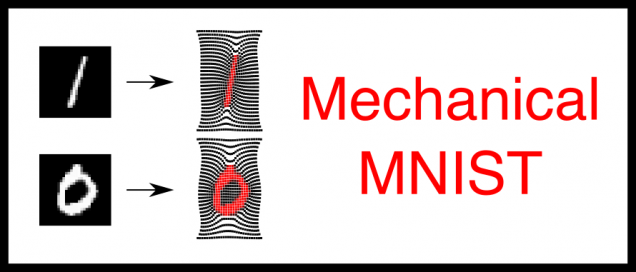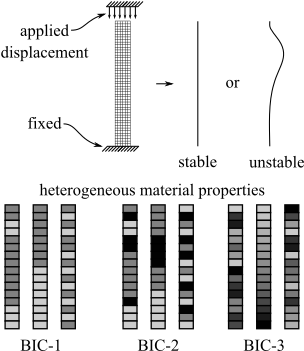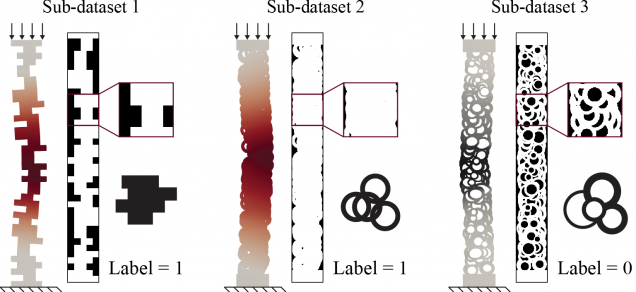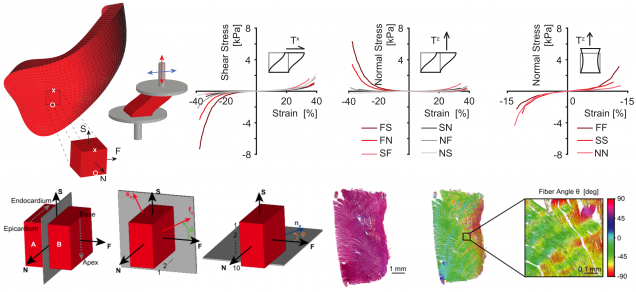Software+Datasets
Check out our GitHub page (this will be way more up to date than this page)! In addition to the examples highlighted below, we have multiple repositories associated with collaborative papers and projects (e.g., analyzing cardiac microbundles, analyzing wounded microtissue, fitting a one-term Ogden model).
We also discuss the topic of open access data for mechanics further in our iMechanica Journal Club post: https://imechanica.org/node/25935 and we are working on a list of open access mechanics datasets created by both us and others: https://elejeune11.github.io/ — please get in touch if you have something that you would like to contribute to the list!
Mechanical MNIST

Each dataset in the Mechanical MNIST collection contains the results of 70,000 (60,000 training examples + 10,000 test examples) finite element simulation of a heterogeneous material subject to large deformation. Mechanical MNIST is generated by first converting the MNIST bitmap images (http://www.pymvpa.org/datadb/mnist.html) to 2D heterogeneous blocks of material. Consistent with the MNIST bitmap (28 x 28 pixels), the material domain is a 28 x 28 unit square.
Dataset — GitHub Transfer Learning Project — GitHub Original Paper
Buckling Instability Classification (BIC)

The Buckling Instability Classification (BIC) datasets contain the results of finite element simulations where a heterogeneous column is subject to a fixed level of applied displacement and is classified as either “Stable” or “Unstable.” Each model input is a 16×1 vector where the entries of the vector dictate the Young’s Modulus (E) of the corresponding portion of the physical column domain. Each input file has 16 columns one for each vector entry. For each 16×1 vector input, there is a single output that indicates if the column was stable or unstable at the fixed level of applied displacement. An output value of “0” indicates stable, and an output value of “1” indicates unstable. In BIC-1, we only allow two possible discrete values for E: E=1 or E=4. In BIC-2, we allow three possible discrete values for E: E=1, E=4, or E=7. In BIC-3, we allow continuous values (to three digits of precision) of E in the range E=1–8. BIC-1 consists of 65,536 simulation results. This exhausts the entire possible input domain. BIC-2 consists of 100,000 simulation results. This is less than 1% of the entire possible input domain. BIC-3 also consists of 100,000 simulation results. This is a tiny fraction of the entire possible input domain.
Asymmetric Buckling Columns (ABC)

The Asymmetric Buckling Columns (ABC) dataset contains spatially heterogeneous columns with fixed-fixed boundary conditions that are classified as either left buckling (label of 0) or right buckling (label of 1). The dataset is split into 3 subdatasets: sub-dataset 1, sub-dataset 2, and sub-dataset 3, each with increasing levels of geometric complexity. For each sub-dataset, we provide information to perfectly reconstruct the domain geometry as txt files as well as graphs constructed from Simple Linear Iterative Clustering (SLIC) segmentation with varying degrees of node density as json files. In brief, sub-dataset 1 is generated by stacking blocks with varying widths, sub-dataset 2 consists of overlapping rings of identical size, and sub-dataset 3 consists of overlapping trimmed rings of varying size. The provided json graph files are the graphs used to train the neural networks in the corresponding manuscript. All sub-datasets contain 25,000 simulation results. In addition to designing ML models for classifying the column behavior, we also welcome others to implement methods for gaining mechanistic insight from these data.
Dataset — GitHub — Manuscript — Poster
Right Ventricular Myocardial Mechanics

The RV-Mechanics dataset contains the raw data from our collaborative publication (led by the Soft Tissue Biomechanics Lab at UT Austin) on the mechanics of right ventricular myocardium. Specifically, it contains the force-displacement data from simple shear experiments on both right and left ventricular myocardium, the sample dimensions for each test, and histological data for each RV sample. The histological data are images of Mason Trichrome stained longitudinal and radial slices across the same tissue samples as used for the mechanical tests. More info can be found here. This is a great resource for anyone interested in testing out data-driven constitutive models for soft biological tissue!
Sarc-Graph

A better fundamental understanding of human induced pluripotent stem cell-derived cardiomyocytes (hiPSC-CMs) has the potential to advance applications ranging from drug discovery to cardiac repair. Automated quantitative analysis of beating hiPSC-CMs is an important and fast developing component of the hiPSC-CM research pipeline. Here we introduce “Sarc-Graph,” a computational framework to segment, track, and analyze sarcomeres in fluorescently tagged hiPSC-CMs. Our framework includes functions to segment z-discs and sarcomeres, track z-discs and sarcomeres in beating cells, and perform automated spatiotemporal analysis and data visualization. This work was supported by CELL-MET, a multi-institutional National Science Foundation Engineering Research Center in Cellular Metamaterials (EEC-1647837). CELL-MET aims to grow functional and clinically significant heart tissue while simultaneously developing a talented and diverse workforce to tackle future challenges in synthetic tissues engineering.
MultiRes-WNet

We have designed a deep learning network architecture that is highly effective for predicting full-field QoI for mechanical problems (e.g., displacement/strain fields, damage fields). Due to the added complexity of full-field information, network architectures that perform well on single QoI problems may perform poorly in the full-field QoI problem setting. We welcome others to both directly use our model architecture on their datasets, and design new models that exceed our baseline performance for predicting full-field QoI on our open source datasets.
Dataset — Dataset Extended Version — GitHub — Publication — Poster
Don’t hesitate to get in touch with questions!
We ran many of these simulations with FEniCS.
Here is an example of our boilerplate data management plan for anyone interested.